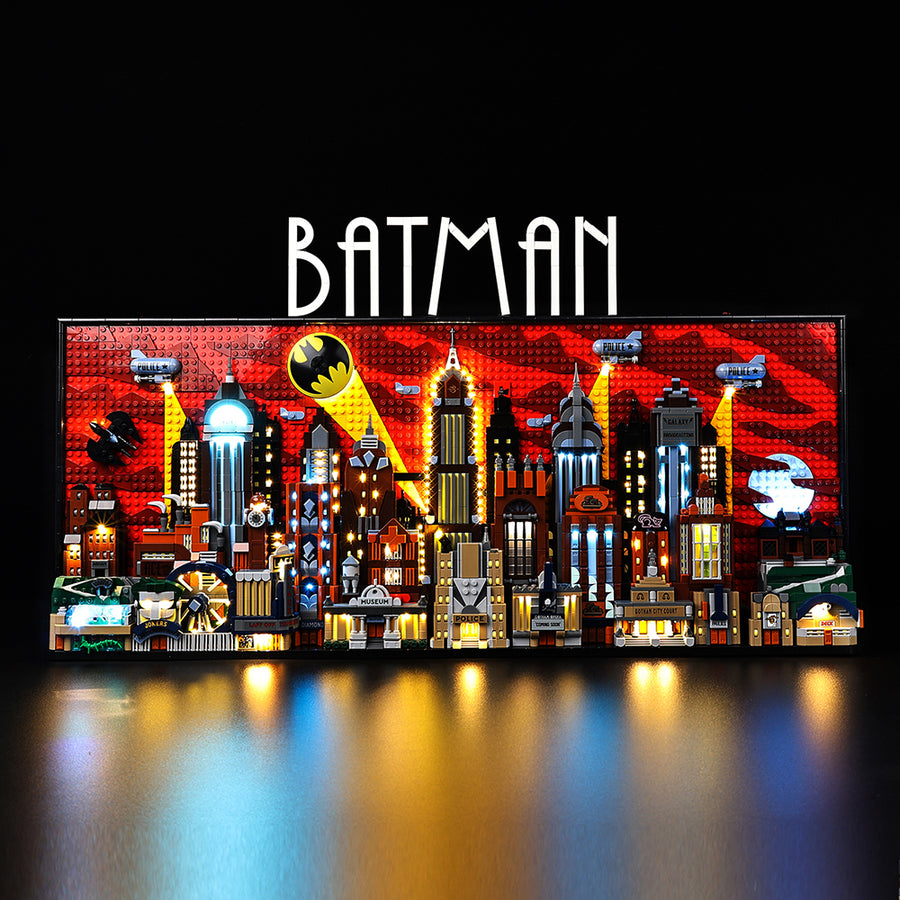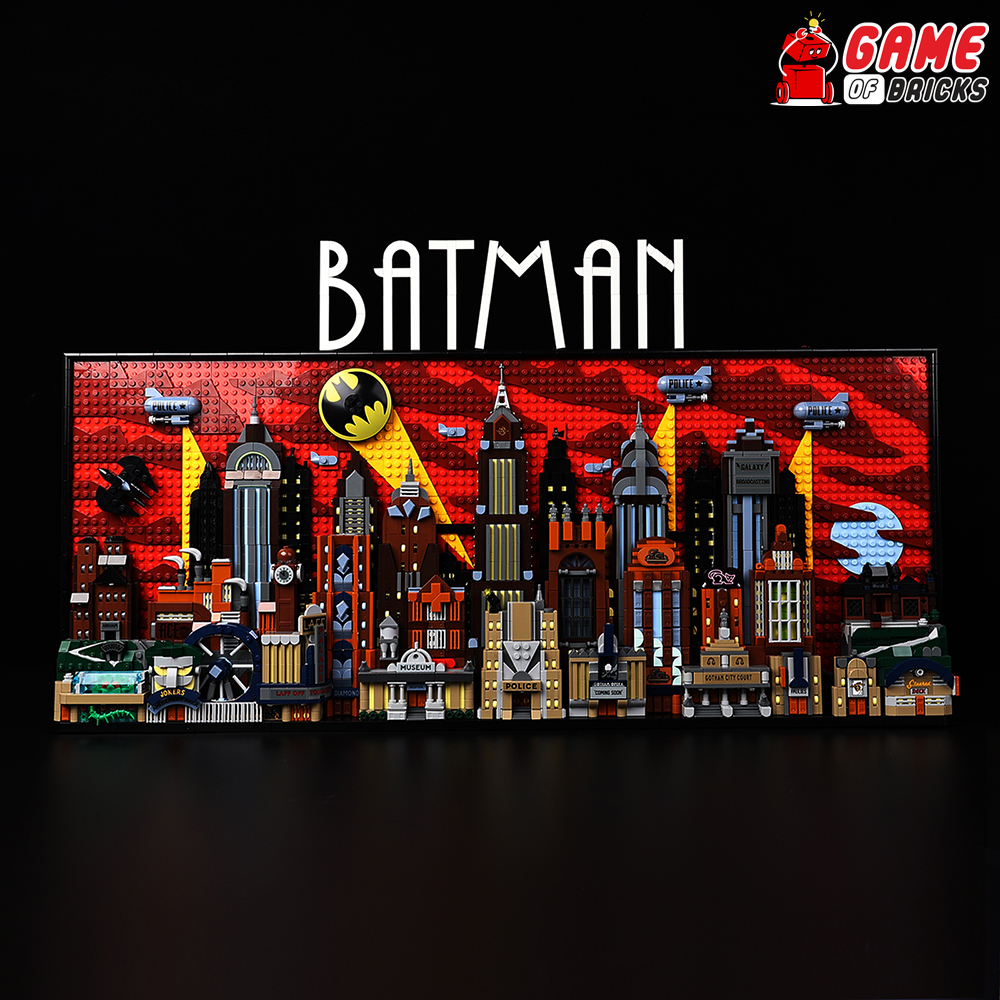How To Easily Start Lighting Up Your LEGO® Building
Introduction
The world of LEGO® building is one of endless creativity and imagination, where tiny bricks come together to form intricate designs and landscapes. Yet, there's a simple enhancement that can elevate these creations to new heights: lighting. The addition of lights to LEGO® sets transforms them from static displays into dynamic, eye-catching works of art, infusing them with life and vibrancy. It’s like turning on the lights in a miniature city, suddenly revealing all the hidden details and colors in their full glory.
Introducing lighting to LEGO® sets is more than just a visual upgrade; it enhances the entire play and display experience. It allows builders to capture the true essence of their creations, whether it's the glowing windows of a skyscraper, the subtle headlights of a car, or the mystical aura of a fantasy castle. This guide focuses on "how to light up LEGO® sets," showcasing it as a straightforward and enjoyable process that is accessible to LEGO® enthusiasts of all ages.
Whether you are a seasoned builder or just starting, lighting up your LEGO® sets opens up a new dimension of enjoyment and creativity. It’s an invitation to explore your sets in a new light (quite literally) and to add a personal touch that makes your creations stand out. So, let’s dive into the illuminating world of LEGO® lighting, where every brick and every light plays a part in bringing your imaginative worlds to life.
Section 1: Understanding the Basics of LEGO® Lighting
Subsection 1.1: Importance of Lighting in LEGO® Sets
The addition of lighting to LEGO® sets brings a new dimension of aesthetic and immersive appeal that goes beyond basic construction. Here’s why lighting is a game-changer in the world of LEGO®:
- Enhanced Aesthetics: Lighting adds depth and vibrancy to LEGO® builds, making colors pop and details stand out. It transforms a model from a static display into a dynamic scene, capturing the nuances of real-life scenarios.
- Increased Immersion: For playsets, lighting elevates the play experience by creating a more realistic and engaging environment. It helps set the mood, whether it’s the eerie glow in a haunted house or the bustling lights of a cityscape, enhancing the storytelling aspect of LEGO® play.
- Showcasing Details: Often, the intricate details of a LEGO® set can be lost in the shadows. Strategic lighting helps in highlighting these features, ensuring that every element of the build is appreciated.
-
Creating Emotional Impact: Lights have the power to evoke emotions, whether it's the warmth of a cozy LEGO® home or the excitement of a brightly lit amusement park. The right lighting can turn a LEGO® set into an evocative piece of art.

Subsection 1.2: Choosing the Right Lights
Selecting the right light sources is crucial for achieving the desired effect in your LEGO® sets. Here are some guidelines to help you make the best choice:
- LED Kits: These are specially designed for LEGO® sets and often come with everything you need for installation, including lights, wires, and power sources. They are ideal for those who want a comprehensive, tailored lighting solution.
- Individual LEDs: For more customized or smaller projects, individual LEDs offer flexibility. They come in various sizes and colors, allowing for precise placement and control over the lighting effect.
- Battery vs. USB Power: Consider whether you prefer a portable power source like batteries or a more consistent power supply like USB. Battery-powered lights offer more flexibility in placement, while USB lights provide a steady light source without the need for frequent battery changes.
- Brightness and Color: Assess the brightness level and color of the lights. Bright white lights are great for modern city scenes, while softer, colored lights can be used for specific thematic effects, like a blue glow for underwater scenes.
- Heat Emission: Ensure that the lights do not emit too much heat, as this can damage LEGO® bricks over time. LEDs are usually a safe choice as they are low-heat.
By understanding the importance of lighting in LEGO® sets and choosing the right lights, you can significantly enhance the aesthetic and immersive qualities of your builds, turning them into captivating pieces that stand out in both form and function.
Section 2: Planning Your Lighting Setup
Subsection 2.1: Designing Your Lighting Layout
Creating a lighting plan for your LEGO® set is a critical step in ensuring that your illumination enhances the build without overwhelming it. Here are some tips to help you design an effective lighting layout:
- Identify Focal Points: Determine which parts of your LEGO® set should be highlighted. It could be the interior of a building, the engines of a spaceship, or the windows of a vehicle. These focal points should guide your light placement.
- Consider Light Distribution: Aim for even light distribution to avoid overly bright or dark spots. Think about how the light will interact with the colors and textures of your LEGO® bricks.
- Integrate Lights Seamlessly: Plan how to incorporate lights in a way that they complement the build. Lights should feel like a natural part of the set, rather than an afterthought.
- Hidden Wiring: Think about how you will run the wires. They should be hidden as much as possible to maintain the aesthetic integrity of your set. LEGO® pieces can be used creatively to conceal wiring.
-
Test Your Ideas: Before finalizing your plan, test different lighting positions and effects. This can be done by temporarily placing lights on your build to see how they look.

Subsection 2.2: Selecting Power Sources
Choosing the right power source for your LEGO® set’s lights is as important as the lights themselves. Here’s a look at the different options:
- Batteries: Battery power is a great option for portability and ease of use. It’s ideal for sets that will be moved around or don't have easy access to a power outlet. However, keep in mind the need for regular battery replacements.
- USB Power: USB-powered lights offer a more consistent power supply and are ideal for stationary displays. They can be powered via a computer, a power bank, or a USB wall charger. This option is practical for long-term displays but does limit the mobility of the set.
- Mains Power: For permanent or semi-permanent LEGO® displays, mains power is a reliable option. It ensures a continuous and stable power supply but requires access to a power outlet and potentially more complex wiring.
Each power source has its benefits and limitations. Your choice will depend on factors such as the location of your LEGO® set, the desired longevity of the display, and ease of access for power.
By carefully planning your lighting layout and choosing the right power source, you can create a LEGO® set that not only looks stunning with its new illumination but also functions seamlessly in its intended environment.
Section 3: Installing Lights in Your LEGO® Sets
Subsection 3.1: Step-by-Step Installation Guide
Installing lights in your LEGO® sets can be straightforward and safe with the right approach. Here’s a simple guide to help you through the process:
- Prepare Your LEGO® Set: Before beginning, ensure your LEGO® set is clean and accessible. If you're retrofitting a built set with lights, you may need to carefully remove some bricks to access internal areas.
- Lay Out Your Lights and Wires: Based on your lighting plan, lay out the lights and wires on or around your set. This helps you visualize the final look and make any necessary adjustments before securing everything in place.
- Start at the Power Source: Begin by positioning your power source (battery pack, USB connector, etc.) in a convenient and discreet location. Ensure it's easily accessible for power management.
- Run Wires and Position Lights: Carefully run the wires through your set, concealing them as much as possible. Use LEGO® bricks and plates to secure the wires in place. Position the lights according to your plan, ensuring they are securely attached.
- Test the Lights: Once all the lights are in place, test them to make sure they work and create the desired effect. Check for any loose connections or misaligned lights and adjust as necessary.
-
Final Assembly: Once you’re satisfied with the lighting, reassemble any parts of the LEGO® set that were disassembled for the installation. Ensure that all wires are neatly tucked away and that the overall aesthetics of the set are maintained.

Subsection 3.2: Customization and Creative Techniques
While functionality is key, creativity plays a significant role in lighting up your LEGO® sets. Here are some ways to customize your lighting setup:
- Thematic Lighting: Match the lighting colors and effects to the theme of your set. For example, use blue and green lights for underwater scenes or warm yellow lights for a cozy cottage.
- Dynamic Effects: Consider using flickering or pulsing lights to simulate fire, screens, or other dynamic elements within your set.
- Layering Lights: Combine different types of lights for a layered effect. For instance, use spotlights to highlight key features and softer ambient lights for background illumination.
- Interactive Elements: If possible, incorporate interactive elements like switches or dimmers that allow you to control the lighting, adding an extra layer of engagement.
By following these installation steps and embracing customization, you can effectively and safely light up your LEGO® sets, enhancing their appeal and bringing a new level of enjoyment to your LEGO® experience.
Section 4: Tips for Maintenance and Safety
Subsection 4.1: Ensuring Safe Use
Safety is a paramount concern when incorporating lighting and electrical components into LEGO® sets. Here are some key considerations to ensure safe usage:
- Electrical Safety: Always use lights and components that are rated for safe use. Avoid modifying electrical parts, as this can create hazards.
- Heat Management: LED lights are preferable as they emit minimal heat. However, ensure there is adequate ventilation around the light source to prevent any heat buildup which could damage LEGO® bricks over time.
- Secure Installation: Make sure that all lights and wires are securely installed. Loose components not only pose a safety risk but can also lead to malfunctions.
- Child Safety: If the lighted LEGO® set is accessible to children, ensure that all electrical components are enclosed and secured. Small parts should be out of reach to avoid choking hazards.
-
Water and Moisture: Keep your lighted LEGO® sets away from water and moisture, as this can damage both the electrical components and the LEGO® bricks.

Subsection 4.2: Maintaining Your Lighted Sets
Proper maintenance is essential to keep your lighted LEGO® sets in good working condition. Here’s how to care for them:
- Regular Inspections: Periodically check the connections and wires for any signs of wear or damage. Loose connections can cause the lights to flicker or fail.
- Battery Management: If your set is battery-powered, monitor the battery life and replace batteries as needed. Remove batteries if the set will not be used for an extended period to prevent leakage.
- Cleaning: Dust your LEGO® set regularly to maintain its appearance and functionality. Use a soft, dry brush or cloth to gently clean the bricks and lights.
- Troubleshooting Common Issues: If lights stop working, first check the connections and ensure the power source is functional. Replace any faulty bulbs or wires as needed.
- Storage: When storing your lighted LEGO® set, disassemble it if possible to reduce stress on the wires. Store it in a cool, dry place to prevent damage to both the LEGO® bricks and the electrical components.
By adhering to these safety and maintenance guidelines, you can enjoy your lighted LEGO® sets with peace of mind, knowing they are safe to use and well-cared for, thus extending their lifespan and ensuring ongoing enjoyment.
Conclusion
In summary, lighting up your LEGO® sets is a straightforward and enriching endeavor that can breathe new life into your creations. From understanding the importance of choosing the right lights to planning and executing a thoughtful lighting layout, each step in this process opens up a world of creative possibilities. By selecting appropriate light sources and power options, and by carefully integrating these elements into your LEGO® builds, you can transform ordinary sets into vibrant, eye-catching displays.
This guide has walked you through the essentials of lighting up LEGO® sets, emphasizing both the fun and functional aspects of this addition. Whether you’re looking to highlight the intricate details of your build, set a mood, or simply add a touch of brilliance to your creations, lighting offers an avenue to enhance and personalize your LEGO® experience.
We encourage you to experiment with different lighting techniques in your LEGO® projects. Embrace the process of designing, building, and illuminating your sets. The creativity and joy that comes with adding lights to your LEGO® builds are boundless, and the results can be truly spectacular. So, gather your bricks and lights, and start on this illuminating journey to bring your LEGO® creations to a whole new level of excitement and beauty.
Call-to-Action (CTA)
Now that you’re equipped with the knowledge to light up your LEGO® sets, we invite you to share your luminous creations with the world! Post pictures of your illuminated builds on social media, join LEGO® forums, or participate in online communities dedicated to LEGO® enthusiasts. Don’t just stop there – continue to explore and experiment with different lighting ideas and techniques. Your innovative designs can inspire others, helping to cultivate a vibrant community of LEGO® lighting enthusiasts. Share your successes, challenges, and tips, and be a part of a collective journey in bringing LEGO® creations to a whole new level of brilliance.
Closing
Final Thoughts: Adding lights to your LEGO® sets is more than just a building task; it's a transformative experience that brings your creations out of the shadows and into the spotlight. Embrace this rewarding journey and watch as your LEGO® builds come alive with the magic of light, turning every brick and beam into a glowing masterpiece of creativity and innovation.
Top












Leave a comment